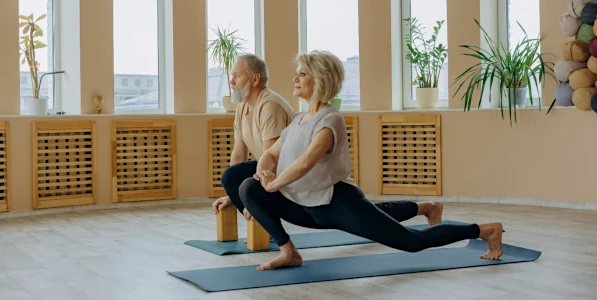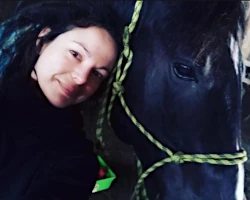Misconceptions About Yoga
Tuesday, April 12, 2022, 09:55 AM
Yoga Doesn't Care About Flexibility, Age, Religion, or Gender, So Why Should You?
If you think doing a handstand or being able to wrap your leg around your neck is what it takes to be a master yogi, we challenge you to think again!
Yoga is more than just complicated poses, deep breaths, and meditation. It is an ancient practice rooted in the alignment of mind and body. From the Sanskrit word Yuj, yoga means to yoke or unite.
We asked NHPC member and yoga instructor Kathryn Bonner to help demystify the misconceptions that hinder people's interest in yoga and why some first-time yogis hesitate to hit the mat.

All Yoga is the Same
Different people practise multiple types of yoga. Which type of yoga you choose to practise depends highly on your goals and fitness level.
Some types of yoga include:
Hatha Yoga
When you think of yoga, Hatha is probably the first one that comes to mind. It serves as an umbrella term for all yoga types that teach physical poses. This type of yoga challenges your strength and flexibility.
Ashtanga Yoga
This type of yoga follows ancient yoga teachings. It focuses on improving breathing, balance, and coordination. It is a more dynamic and athletic form of Hatha yoga.
Bikram Yoga
Have you experienced hot yoga? Bikram follows the 26 postures ¾ repeated twice ¾ popularized in the 1970s. This type of yoga is practised at 40 degrees Celsius. Although any yoga can be practised with heat, often hot yoga is associated with Bikram.
I Am Not Flexible or Fit Enough for Yoga
"I can't reach my toes."
It's a good thing toe reaching is not a prerequisite of yoga!
Yoga instructors encourage you to be mindful of your practice and your own body. This means you should listen to what your body tells you, such as how far you need to bend to feel a stretch or how soon you need to rest to give your body a break.
"Every individual's DNA controls and shapes the skeleton, determining our general body characteristics. We all have the same joints, muscles, and tissues. Still, not everybody has the same capabilities since we are all structured differently. Something good for you can be very dangerous for someone else," Kathryn explains.
She advises people to stop comparing themselves to others and start looking inwards for peace.
Finding the correct type of yoga for your physical agility and comfort level is one way to combat this misconception.
Yoga is Religious
Although many people associate yoga with religious practice, yoga in itself is not a religion. It does stem from religious practices of Hinduism, Jainism, and Buddhism.
There are no Sunday meetups, prayers, or scripture readings that need to take place for one to reap the benefits of yoga.
Anyone can practise yoga regardless of their faith, culture, or ethnicity. The commitment and awareness you bring to your practice propels you to achieve bliss.
Older People Can't Do Yoga
The beauty of yoga is that it embraces all ages. Seniors may struggle to do poses lying down on their mats or find it hard to get back up. The introduction of chair yoga is a game changer!
This type of yoga has been fully modified for people to perform exercises and poses from a seated position. Yoga instructors guide you through a series of breathing techniques and stretching exercises.
It helps with chronic pain and symptom management and increases flexibility, mobility, core strength, and balance.
If you're going to spend the next 30 minutes sitting down, you may as well feel good about it!
Yoga Is Not a Workout
"If I want to sweat, I'll go to the gym. If I want to sleep, that's when I'll go to yoga."
Different types of yoga target different elements of your mind and body.
If your goal is to sweat, then a 40-degree Celsius room filled with 20 people will get you there. Yoga does not involve bars or weights but holding poses for some time can feel like a marathon.
With every breath you take, you sink deeper into your posture, and with every second you breathe out, you feel a bead of sweat trickle down your face.
Yoga may not have weights clattering on the floor, but it trains your mind to hold steady and pushes your body to find strength and flexibility to maintain balance.
Only Women Do Yoga
"I think I'll leave that for my wife to do."
Although many women practise yoga, it is not limited to one gender only.
According to a 2016 survey on yoga, the number of men practising yoga increased from four million to ten million. Don't let gender norms dictate who can and can't practise yoga. You'll likely see people of all ages, genders, and backgrounds in class.
Anyone Can Teach Yoga
Having been to a yoga class or reading about the practice does not certify anyone to teach yoga. If yoga is done incorrectly, it can create risks to the human body. Yoga instructors go through extensive training to get their certification.
The NHPC recognizes yoga instruction as a holistic health modality. We require 200 hours of training:
- 50 hours in core sciences (i.e., basic anatomy and physiology, client/therapist relationship)
- 100 hours in theory and application
- 40 hours in teaching methodology
- 10 hours of practicum
Kathryn obtained her Registered Yoga Teaching (RYT) 200 in Hatha yoga in 2021.
Interested in Learning More About Yoga?
If you've been curious about yoga, now is your chance to hit the mat. Don't go into a class with these misconceptions in mind; instead allow yourself the freedom to connect with your mind and body.
Unsure which yoga type is best for you? Read about nine different types of yoga!
About Kathryn Bonner
 Kathryn graduated from McKay Massage and Hydrotherapy College in Saskatoon, Saskatchewan, in 2009. She has been a member of the Natural Health Practitioners of Canada since 2010.
Kathryn graduated from McKay Massage and Hydrotherapy College in Saskatoon, Saskatchewan, in 2009. She has been a member of the Natural Health Practitioners of Canada since 2010.
Her passion for nature and the healing properties of plants led to her aromatherapy certification in 2013. She specializes in deep tissue, myofascial cupping, RAPID, pregnancy massage, and essential oil massage. Kathryn is constantly learning through her continued education.

